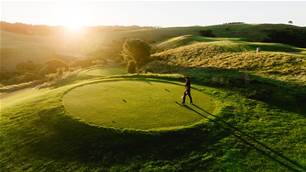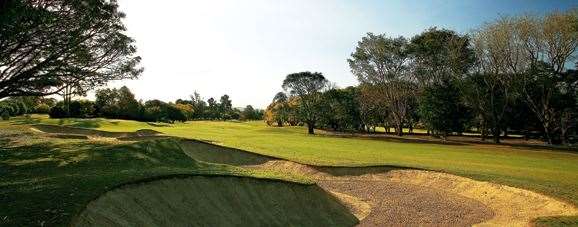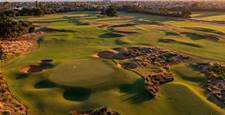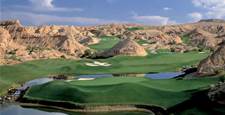Three years on from the devastating floods that inundated this 36-hole complex, Indooroopilly is impressing once again.
WORDS & PHOTOGRAPHY BY BRENDAN JAMES
Indooroopilly Golf Club was the worst hit of Brisbane's courses during the devastating floods of January 2011. Three years on and the 36-hole complex is impressing once again.
It is three years since the eyes of a nation were transfixed on our televisions as the people of Queensland endured yet another natural disaster. The floods of January 2011, which swept through Rockhampton as well as south-east Queensland, and into the Brisbane CBD, were another stark reminder of the power of Mother Nature and the devastation she can cause.
At the height of the emergency, the swollen Brisbane River burst its banks creating floodwater levels not seen since the record 1974 floods that inundated the city. This time, though, the images of a city fighting to keep its head above water were beamed live into our homes or were splashed across the front pages of the newspaper.
One of the unforgettable images for me during that time was an aerial photograph showing the floodwaters covering most of the surfboard fin-shaped land (known as Long Pocket) occupied by Indooroopilly Golf Club, which is bound on three sides by the Brisbane River as it flows east towards the city. Of the 36 holes on the 130-hectare property, 22 holes were completely swamped by the floodwater and the tonnes of sand, silt and mud that came with it.
In the days after, as the waters receded the full extent of the devastation became apparent. Almost every tee and green was damaged to some degree. One fairway, which runs alongside the river, was buried under a metre of sand and sludge.
More than 350 member volunteers joined course superintendent Charlie Giffard and his staff in the clean-up operation. Armed with
shovels and pushing wheelbarrows, the massive working bee removed the layers of mud and silt off the affected greens, which were then washed and squeegeed clean. This helped save the greens from completely dying. It also went a long way to having all 36 holes opened for play within two months.
Today, there is virtually no evidence of the 2011 flood to be seen at Indooroopilly, with the exception of a few flood level markers you might spot during the course of a round. Both courses have returned to the high standard of presentation that had been established before the flood and both layouts are destined to get even better.
As mentioned, Indooroopilly has 36 holes, which are split into four coloured nines – Gold, Red, Blue and Green – allowing the club to operate six 18-hole combinations. Of these, the West Course (Red and Gold) and the East Course (Green and Blue) are the most commonly used.
The club, which was first established at nearby St Lucia in 1926, has had a presence at Long Pocket since 1964 when the club built a course there to meet with demand for tee-times from the public and the club’s members at St Lucia.
In 1985, having developed 36 holes across two decades at Long Pocket, the club moved from St Lucia to its current home. The original 18-hole layout became known as the ‘Old course’, and the second 18 holes was called the ‘New course’. However, with the redesign of the older layout by Ross Watson in 1985, the Old course was later renamed the West course and the second 18 holes became the East course.
Watson also oversaw major changes to the West as part of a masterplan for the entire complex, to help triple the water-storage capacity for the club, and these holes were opened for play in 2008. This redevelopment also gave rise to some of Indooroopilly’s most memorable and challenging holes.
Today, the West course is widely regarded as Indooroopilly’s best and was ranked No.93 in Golf Australia’s list of our Top-100 Courses published in January this year, after not being ranked in 2012 because of the damage to the course caused by the floods.
Heading out on the front nine of the West (the Red nine), the examination of your nerve and skill begins from the opening shot. The 513-metre par-5 can be reached in two shots by long hitters but they must be willing to thread their drive between a lake to the right and trees to the left of a narrow landing zone. For the rest of us, the lake still comes into play (it’s only 180 metres from the white tee) but the fairway is much wider. Stay dry from the tee, maintain a good line with your second down the left half of the fairway and you will be left with a straight-forward approach to a slightly elevated green.
Water plays a significant role on the holes of the Red nine, as does the changing elevation. The quartet of holes starting at the short par-4 6th is, for mine, the most interesting sequence of holes at Indooroopilly. The 6th hole demands a well-struck drive across the edge of a gully to find the fairway, which lies diagonally off to the right. The drive at the 7th, which is index 1 on the West course, must also be straight to avoid the lake on the right. A water carry with your long second shot is also required to find the green beyond another lake, this one bordering the front and left edge of the green.
The par-3 8th offers some respite from the water but it is back again at the 478-metre 9th where you must bomb a drive over a lake to the fairway, again diagonally placed to the flight of the your tee shot, before taking on more water with your final approach to a semi-island green where there is water short, left and long of the putting surface. It is a treacherous journey from tee to green here, but what a closer to the front nine.
Sand plays a more dominant role on the West course’s back nine, or Gold nine, with expansive bunkering complexes on the par-5 3rd, par-4 6th and par-5 7th holes the most visually intimidating across the Indooroopilly landscape. Of this trio, I really liked the 3rd hole. Step onto the tee here and you are standing right on the banks of the Brisbane River (during the flood, this tee was under five metres of water). While the hole follows the edge of the river, the fairway veers slightly to the right, around a crop of bunkers left, before doglegging slightly left to bring trees and more sand into play for the second shot. Thankfully, there is plenty of fairway to be found right of the bunkers, which are within pitching distance of the front of the tabletop-shaped green.
The 311-metre par-4 9th is one of the holes that changed dramatically as part of Watson’s redesign and it offers a grandstand finish to the round with a narrow fairway flanked by a lake to the left, while four bunkers protect the deep, contoured green that sits within an amphitheatre beneath the gazing eyes of those in the clubhouse.
The West course, quite rightly, grabs most of the plaudits for Indooroopilly. But there is still plenty to like about the variety and quality of the holes to be found on the East course (Blue and Green nines), which features much less bunkering and fewer water hazards than the West. For mine, the Blue is the better of the two halves and is probably my second favourite nine at Indooroopilly behind the Red nine. While the holes are generally shorter on the Blue nine, the changing elevation, combined with the narrower, tree-lined fairways, gives rise to some strong par-4s, like the 394-metre 6th, as well as some interesting short holes.
The rolling terrain has been used well to create some terrific, under-rated holes on the Green nine as well, with the 3rd, 4th, 5th and 7th being the standouts.
The 324-metre par-4 3rd is just one of the gems. Accuracy from the tee is a prerequisite on this dogleg-left fairway, which rolls over the crest of one hill before climbing again to reach the green. The uphill second shot here is quite deceptive in terms of judging the distance but rest assured you want to be under the hole for your first putt on this green.
In time, many of the holes on the East course will also be redesigned as part of the Watson masterplan. However, given the financial hits inflicted by the 2011 flood, those changes might be some time off, but general manager Gary Cosier says “we’re not in any hurry”.
“The course has recovered well and is probably in the best shape it has been since the flood three years ago,” he said.
I couldn’t agree more.
THE COURSE
LOCATION: Meiers Rd, Indooroopilly. About ten minutes’ drive west of the Brisbane CBD on the banks of the Brisbane River.
CONTACT: (07) 3721 2173 or (07) 3721 2122.
WEBSITE: www.indooroopillygolf.com.au
DESIGNERS: Al Howard & members (1964); Ross Watson (1985, 2006 and ongoing).
PLAYING SURFACES: Greenlees Park couch (fairways); Bermuda 328 (greens).
COURSE SUPERINTENDENT: Charlie Giffard.
PGA PROFESSIONALS: Scott Hayward (director of golf).
GREEN FEES: Indooroopilly welcomes visitors to play the 36-hole course from Sunday to Friday. The club offers six 18-hole combinations. $55 (18 holes midweek), $65 (Sunday). Bookings can also be made online via the club’s website by becoming a registered public member.
THE CLUB
MEMBERSHIPS: Applications for membership are welcomed. Categories of membership are based on playing rights and course access with generous discounts for younger members and the family of existing members.
Full membership has a range of benefits including direct access to 36 holes. The club also boasts Brisbane’s most extensive practice facilities, including a driving range, three putting greens, practice holes and chipping bunkers. Free range balls are also provided for members, while there is also a range of coaching packages and clinics seven days
a week with the club’s PGA professional coaches.
RECIPROCAL CLUBS: Castle Hill, The Lakes, Manly, Newcastle, Pennant Hills, Pymble, Rich River (NSW); Glenelg, Grange, Kooyonga (SA); Commonwealth, Yarra Yarra, Woodlands, Peninsula (Vic); Lake Karrinyup, Joondalup, Mt Lawley, Nedlands, The Western Australia, Royal Perth (WA), Royal Hobart, Launceston (Tas).
CORPORATE GOLF: The club has experienced staff on hand to take the pressure off you and manage the logistics of your golf day. Services include valet bag drop, novelty holes, on-course refreshment carts, on-course banner and furniture placement, private registration and function room.
For full and current golf day packages call the corporate golf co-ordinator Tim Chatfield on (07) 3721 2129.
ACCOLADES: West Course ranked No.93 on Golf Australia’s list of Top-100 Courses, January 2014.
Related Articles
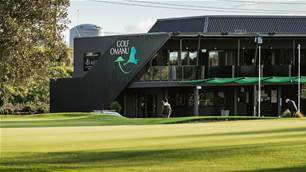
International Spotlight: Omanu Golf Club
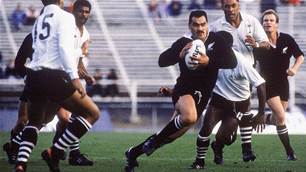
Celebrity Kiwi couple tee off in paradise
